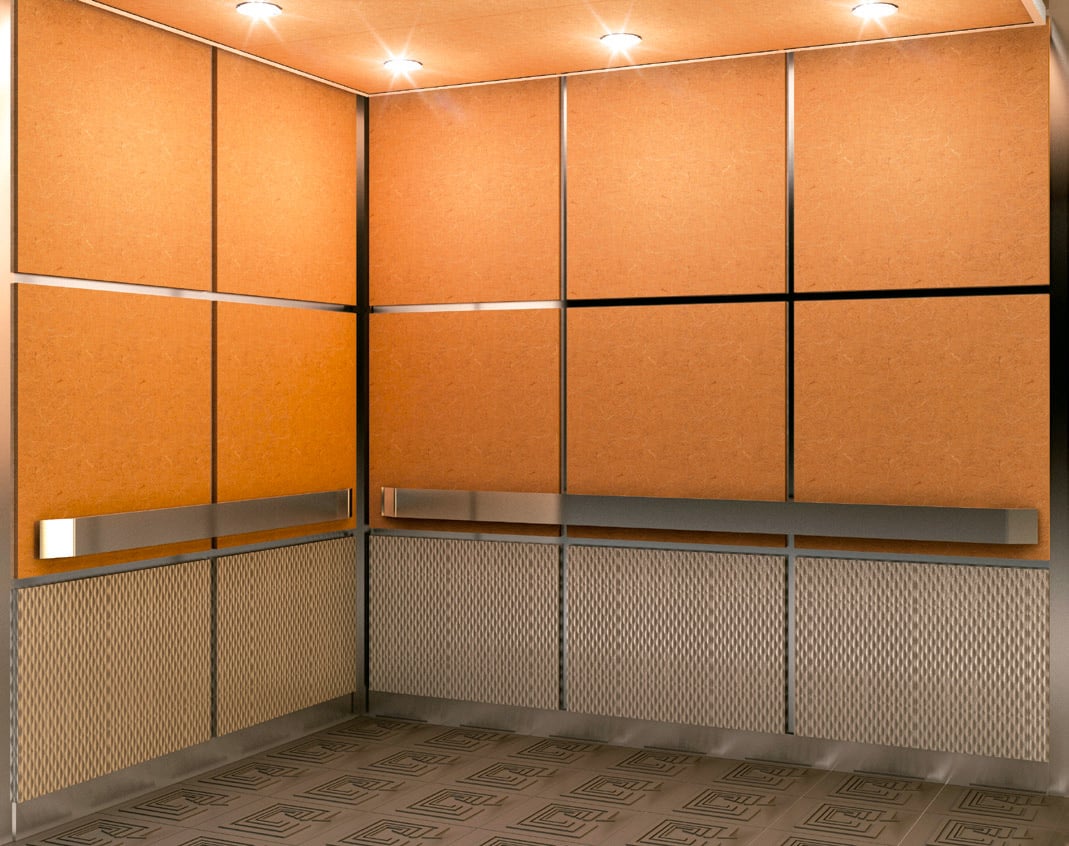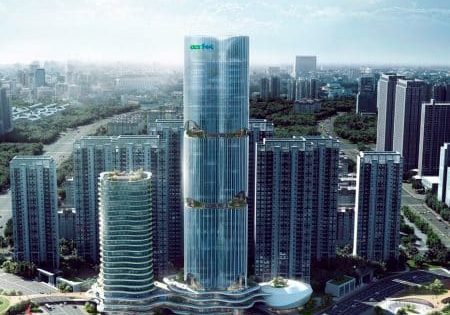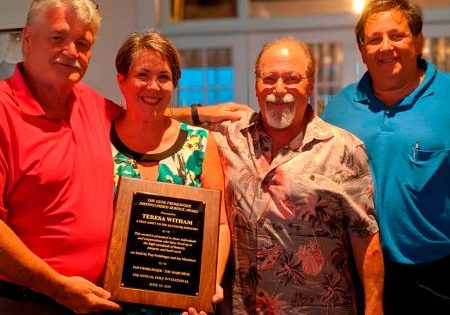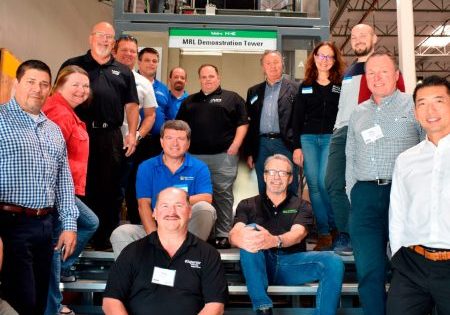Time for Quicker Shipment
Sep 1, 2019

Columbia introduces multiple existing products and a new quotation system that combine to get elevators up and running much sooner than usual.
It is said that you can always make more money but never more time. But, Columbia Elevator Products Co. Inc., headquartered in Bridgeport, Connecticut, is announcing the next-closest thing. Time is money, particularly in the building trades. This can be especially true in the elevator industry, where the cadence of modern building construction techniques (especially for high-rise buildings) demands the increasingly greater compression of delivery times to effectively service an active jobsite.
“For years now, there has been more and more pressure to do things faster and faster,” says Louis “L.J.” Blaiotta, Jr., Columbia’s CEO.
He continues:
“So, we’ve needed to constantly innovate to meet this demand. In new construction, this has been a particularly sensitive issue for us as a cab and door manufacturer, since our products are among the very last pieces in the development sequence to be installed. The natural order of things is for the cab to go on top of the platform, following installation of the rails and other shaft components. A natural side effect is a ‘time squeeze’ that frequently includes requests to make up for unforeseen delays that may have occurred earlier in the construction cycle through no action of our own. It’s been ironic that the custom architectural parts of the elevator system that naturally require the longest approval process often end up getting the least attention until it’s most critical, while the more standard elevator components that can often be obtained off the shelf or with relatively short lead times, such as motors and/or rails, often end up being the sole focus at the beginning of the job.”
There are many items throughout the construction cycle that require approval from the architects and builders. The major, broader issues — such as zoning and the development of concepts for fundraising and approvals by architectural boards — are, by definition, the first to be finalized, while finer design specifics — such as those surrounding the windows, lobby, elevators and other enhancements — get addressed later in the process. While the architects may already have a basic idea of how they want the elevators to look at these earlier stages, they deem fleshing out the details a lower priority to be resolved down the line as occupancy begins to approach. Customizable segments of the elevator system, such as cabs and doors, often end up becoming some of the last items to be approved and, therefore, need to be installed at virtually the very last minute.
Blaiotta explains:
“Under these circumstances, any delay on our part could delay the opening of the building to tenants, since a certificate of occupancy (CO) cannot be issued until the building is equipped with usable elevators. This led to our development of a dual-track approach to new construction using our InstaCab® and XchangaCAB® (XCC) technologies, both of which we initially created for use in modification jobs and have now been repurposed to accelerate the process of securing a CO. During the first phase, we ship basic steel shells. These are not yet architecturally developed, but are structurally complete and configured with all the ventilation, lighting and other components required to achieve code compliance.”
By no means pretty, Columbia’s InstaCab shells are functional, safe, code-compliant cabs that enable the issuance of occupancy certificates. On a practical level, they are also immediately available to be pressed into actual service as construction hoists for floor-to-floor travel, while work on the rest of the building continues. Meanwhile, approvals for the cabs’ interior treatments can be sought. Once they are secured, Columbia enters the second phase by shipping its XCC hanging panels and architectural refinements to be added to the operational shell (often following tenant move-in). This timing spares the interior finishes any damage that might occur during the moving process and provides the opportunity to best match the elevator’s final look to that of the tenant’s overall interior design aesthetic, such as that found in the lobby. The company can deliver all the needed materials in progressive stages for installation when and where they are needed, with the final approval process occurring parallel to the construction timeline and thereby not pushing out the building’s completion date.
To deliver these compressed timelines, Columbia began prefabricating, acquiring and stocking major cab components to be available for immediate shipment upon job approval. Examples include cab shells of certain sizes/capacities, prebuilt for quick shipment with custom-sized filler panels that effectively stretch the cab walls as needed for each application. Available to be shipped along with the basic cab shell are linear MOnxt® operators from GAL, a member of the Vantage family of companies, pre-mounted in the transom to save a significant amount of time and labor on the jobsite.
Regional Vice President of Vantage Eric Lazear explains:
“MOnxt, a line of linear door operators, streamlines and simplifies the job by integrating the clutch and all other components directly onto the header. Its car-door interlock enables a safe, smooth and labor-saving installation process. There is no need for fascia, which makes this system ideal for new elevator installations. When paired with Columbia’s cab and door systems, the elevator contractor simply presses a button, and the system learns all the required door characteristics. It is designed for the next-generation elevator installations currently being seen in the field and the time savings they demand.”
Another inventoried component is an expandable low-voltage LED lighting system, developed in partnership with Man-D-Tec, which includes built-in emergency illumination to support the cab’s code compliance when provided with the basic shell. This was designed to remain in place and, later, serve as a command center for expanded LED lighting when a translucent, suspended ceiling was selected as a final solution or to support additional decorative downlighting options if a solid/island ceiling were installed down the road. In either case, this command center lighting serves to minimize duplication of wiring time and expense as compared with two distinct lighting installations.
The process of architecturally building out and finishing the cab in the field, following tenant move-in, is done by using XCC. Like InstaCab, XCC was initially developed for the modernization market and later adapted as a way to save customers time and money in new construction. Comprising individual panels, XCC enabled the in-place installation of new walls, ceilings, lighting, handrails, etc., which proved to be an ideal methodology for finishing a basic steel shell already installed in a shaft with high potential for architectural expression.
Using a similarly staged approach for the installation of entrances, Columbia has adopted a triple-phase system to compress the timeline on the landing side. Among the first architectural products to ship to the jobsite are the “roughs”: structural components consisting of the struts, sills and headers available with the optional pre-mounting of GAL’s MOnxt tracks.
The next components to ship are the landing frames and transoms (when required). Finally, the landing doors are shipped during the third phase, often at the same time as the cab interiors.
Along the way, Columbia has been implementing numerous marginal steps for quicker delivery times. This includes investment in creating and acquiring more prefabricated items and moving inventories of those finished goods from its factories to distribution centers. This reorganization not only expands the stock of ready-to-ship materials, it also frees additional manufacturing space.
While all these actions have yielded meaningful advancements in response time, the unrelenting marketplace continues to press for even shorter timelines and continuing innovations to render the installation process ever quicker and easier, as Blaiotta explains:
“At every level, from the particular to the overarching, we are working to deliver what the market is demanding to reduce installation time. Some issues that may appear relatively minor or trivial at first glance can, in fact, have major implications for the elevator, not only for ease and speed of installation, but also for durability, safety and cost-savings down the road. At the ‘particular’ level, take, for example, the installation of handrails. When placing an interior of a cab into a shell that has already been installed in a shaft, architectural considerations can inadvertently specify handrail locations that cause mis-drilled holes in the wall. When the entire cab shell and interior are assembled in our shop, it is easy for us to get this right: we simply drill the mounting holes in the wall and place a suspension mechanism in a convenient location behind it. Conversely, one is unable to easily access the back wall in a shaft.”
Service today is all about speed. To use a horseracing metaphor. . . Columbia is now springing into motion several lengths behind the gate to be at full gallop and speed by the time the gate opens!— Columbia CEO Louis “L.J.” Blaiotta, J
For the “quick and easy” solution to this challenge, Columbia has also partnered with Bill Seymour, president of Seymour Technologies — North American representatives for the German company BeLi — to employ a system called e-li, short for “easy link.” According to Tim Lindemann, general manager of BeLi, the structural support of the system is a “strong spine” secured to the outside of the cab shell wall from inside the cab. This spine, made of 5/16-in.-thick steel, comes in an “S”-shaped design with a threaded hole in the center into which the installer inserts a wire tool. Once the holes have been drilled into the cabin wall, this tool allows the spine to be easily snaked through one of these holes. With the spine on the outside of the cabin wall, it can be secured from inside the cabin using provided hardware, and the handrail can be mounted once all the spines have been secured.
Adds Seymour:
“These are far more elegant-looking than previous installations. Plus, the overall shape and size of the ‘S’ spine spreads the load of each handrail mounting point across a 3- X 5-in. area, which boosts the installation’s strength and resistance to vandalism. Although handrails are intended for compliance with accessibility standards to accommodate the disabled, it is common to see people leaning and sitting on them or using them to support the weight of packages and freight. Consequently, with conventional installations, it is not uncommon to later find handrails loose with their mounting method damaged, which our system works to overcome.”
The Fourth Industrial Revolution
The term “Fourth Industrial Revolution” was attributed in 2015 to Professor Klaus Schwab, who, as founder and executive chairman of the World Economic Forum, wrote an article in Foreign Affairs about emerging technologies driving the next definable phase of global business development.
Examples included artificial intelligence, robotics, autonomous vehicles, blockchain and decentralized consensus. Cloud computing is a component of the Fourth Industrial Revolution and is becoming a major factor in the “new Columbia,” Blaiotta says, which the company has dubbed “Columbia 4.0”:
“We’re placing our customers’ data into the cloud, so we can get the front end of each job approved much more quickly and move it that much faster into the factory. At one time, one-third of our production lead time was in the engineering department, and two-thirds was in the factory. We managed to reduce that to half in the factory and, eventually, even less by building up our prefab and acquired inventory for quicker delivery. But, recently, we’ve been consuming less time in the factory than in the approval process, so our next investment has been in advanced software and procedures to shorten the approval times.
“Twenty years ago, we wrote our own parametric 3D modeling system that allowed us to prototype cab and door jobs in virtual space (to ensure all components were the correct size and fit together properly), eliminating the need to do so physically in our shop. Because we were drawing parts to scale and in 3D, we could then export the data directly to the computer- numerically controlled machinery on our factory floor and fabricate the pieces to exact dimensions and size. While a cutting-edge, time-saving innovation for its time, this approach has become more common across the industry, so we’ve embarked on an all-new way of doing business to remain ahead of the curve. The more these efforts succeeded in condensing the time it took to create manufacturing drawings and move jobs to the factory, the greater became the percentage of the lead time consumed by the back-and-forth correspondence associated with finalizing customer approvals. Our new initiative has been to invest in the use and development of software and procedures that will wring significant time out of this phase of the process. We began by using cloud-based software-as-a-service platforms, such as for customer relationship management (CRM), but the gamechanger is our own proprietary online pricing software, developed in-house, and its integration with a web-based customer portal into our CRM.”
Gamechanger
Beginning September 2019, registered Columbia customers will be given access to this system, and, by logging in on a smartphone, tablet, laptop or desktop computer, be able to see previous jobs Columbia has quoted for them to use as templates or start a new job from scratch. Upon answering a series of questions about their jobs, customers will instantly be given a price for their specified designs and be able to tell Columbia directly from their devices when to release the jobs for fabrication. The next generation of the portal will include Columbia’s engineering department, which will automatically create and post preliminary drawings and price status updates for review with a notification to the customer’s phone or other device when these are ready. Customers can annotate or approve them — the latter by signing off via electronic signature and releasing the job to Columbia for manufacture. The drawings and associated documents remain stored in the cloud for access at any time, and Columbia’s customers can, in turn, share them with their clients to download and annotate. Once jobs are in the manufacturing stage, customers will have access via the web- based CRM portal to track progress at will.
There are numerous ways this new model serves to compress the end-to-end timeline. First, it eliminates the cumbersome back-and-forth approval procedure. Instead of needing to wait for final approvals to engineer jobs, Columbia can now pre-engineer and gain a significant jump on the process.
Upon final approval, all the engineers need to do is check for changes and quickly perform any tweaks that may have become necessary. Another consequent timesaver has to do with acquisition of the special materials used today in cabs and entrances, which typically involves long lead times. As Columbia’s production lead times grew shorter, it saw lead times for obtaining these materials — such as nickel silver and specialty stainless steels — become twice the length of the manufacturing time. While the obvious solution would be to preorder the materials, Columbia was unable to effectively do so until it had engineered the job to determine proper yields and order quantities, which traditionally did not occur until the customer had approved the design. With the new system, Columbia will have enough advance information to get customer approval of the special materials to preorder them so that they will be in hand when needed at the fabrication stage. In effect, Columbia is using up-front time, which has traditionally been reserved for thinking about the structure of the building, to get the special materials ordered so that Columbia can move straight to manufacturing once customers have made all their final decisions.
Blaiotta relates his astonishment at how far all this has come since he started out in the business, in terms of the technology now available and the resulting market pressures it has created and enabled. When he first came into the business during his high school years, he would help his father, Columbia founder Louis Blaiotta, Sr., make 22-X-34-in. blueprints, insert them into mailing tubes and ship them to customers for markup and return mailing, a process that could take weeks. Subsequent advancements included the back-and-forth transmission of drawings and documents by fax, then later by email, but even this could still be counterproductively drawn out.
Concludes Blaiotta:
“Now, we have the cloud, where all concerned parties can instantly and collaboratively see and work with whatever they need, whenever they wish. Decades ago, 16-week lead times were acceptable. Then, it was 12 weeks, then eight. These days, customers are pushing for maximum six-week lead times, and we have strategically invested financial and human resources into making this a reality. Service today is all about speed. To use a horseracing metaphor — comparing the older methodologies to a horse at the starting gate — Columbia is now springing into motion several lengths behind the gate to be at full gallop and speed by the time the gate opens!”
Get more of Elevator World. Sign up for our free e-newsletter.








